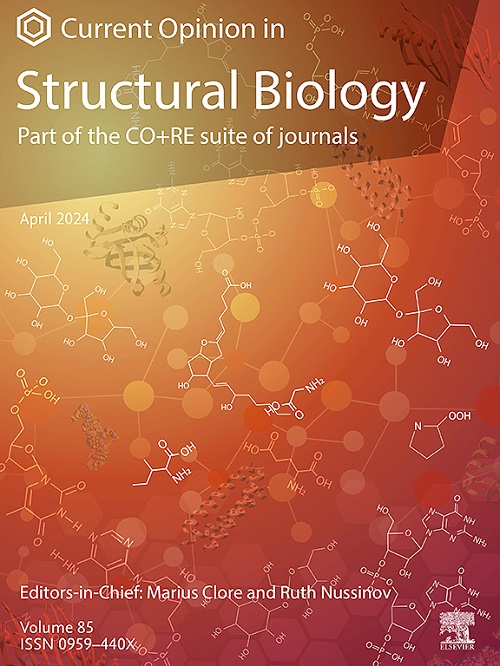Non-canonical amino acids for site-directed spin labeling of membrane proteins
IF 6.1
2区 生物学
Q1 BIOCHEMISTRY & MOLECULAR BIOLOGY
引用次数: 0
Abstract
Membrane proteins remain challenging targets for conventional structural biology techniques because they need to reside within complex hydrophobic lipid environments to maintain proper structure and function. Magnetic resonance combined with site-directed spin labeling is an alternative method that provides atomic-level structural and dynamical information from effects introduced by an electron- or nuclear-based spin label. With the advent of bioorthogonal click chemistries and genetically engineered non-canonical amino acids (ncAAs), options for linking spin probes to biomolecules have substantially broadened outside the conventional cysteine-based labeling scheme. Here, we highlight current strategies to spin-label membrane proteins through ncAAs for nuclear and electron paramagnetic resonance applications. Such advances are critical for developing bioorthogonal spin labeling schemes to achieve in-cell labeling and in-cell measurements of membrane protein conformational dynamics.
用于膜蛋白定点自旋标记的非典型氨基酸。
膜蛋白仍然是传统结构生物学技术的挑战目标,因为它们需要在复杂的疏水性脂质环境中才能保持适当的结构和功能。磁共振与位点定向自旋标记相结合是一种替代方法,可通过电子或核基自旋标记引入的效应提供原子级结构和动态信息。随着生物正交点击化学和基因工程非典型氨基酸(ncAAs)的出现,将自旋探针与生物大分子连接的选择范围大大拓宽,不再局限于传统的基于半胱氨酸的标记方案。在此,我们将重点介绍目前通过 ncAAs 对膜蛋白进行自旋标记以应用于核磁共振和电子顺磁共振的策略。这些进展对于开发生物正交自旋标记方案以实现细胞内标记和细胞内膜蛋白构象动态测量至关重要。
本文章由计算机程序翻译,如有差异,请以英文原文为准。
求助全文
约1分钟内获得全文
求助全文
来源期刊

Current opinion in structural biology
生物-生化与分子生物学
CiteScore
12.20
自引率
2.90%
发文量
179
审稿时长
6-12 weeks
期刊介绍:
Current Opinion in Structural Biology (COSB) aims to stimulate scientifically grounded, interdisciplinary, multi-scale debate and exchange of ideas. It contains polished, concise and timely reviews and opinions, with particular emphasis on those articles published in the past two years. In addition to describing recent trends, the authors are encouraged to give their subjective opinion of the topics discussed.
In COSB, we help the reader by providing in a systematic manner:
1. The views of experts on current advances in their field in a clear and readable form.
2. Evaluations of the most interesting papers, annotated by experts, from the great wealth of original publications.
[...]
The subject of Structural Biology is divided into twelve themed sections, each of which is reviewed once a year. Each issue contains two sections, and the amount of space devoted to each section is related to its importance.
-Folding and Binding-
Nucleic acids and their protein complexes-
Macromolecular Machines-
Theory and Simulation-
Sequences and Topology-
New constructs and expression of proteins-
Membranes-
Engineering and Design-
Carbohydrate-protein interactions and glycosylation-
Biophysical and molecular biological methods-
Multi-protein assemblies in signalling-
Catalysis and Regulation
 求助内容:
求助内容: 应助结果提醒方式:
应助结果提醒方式:


